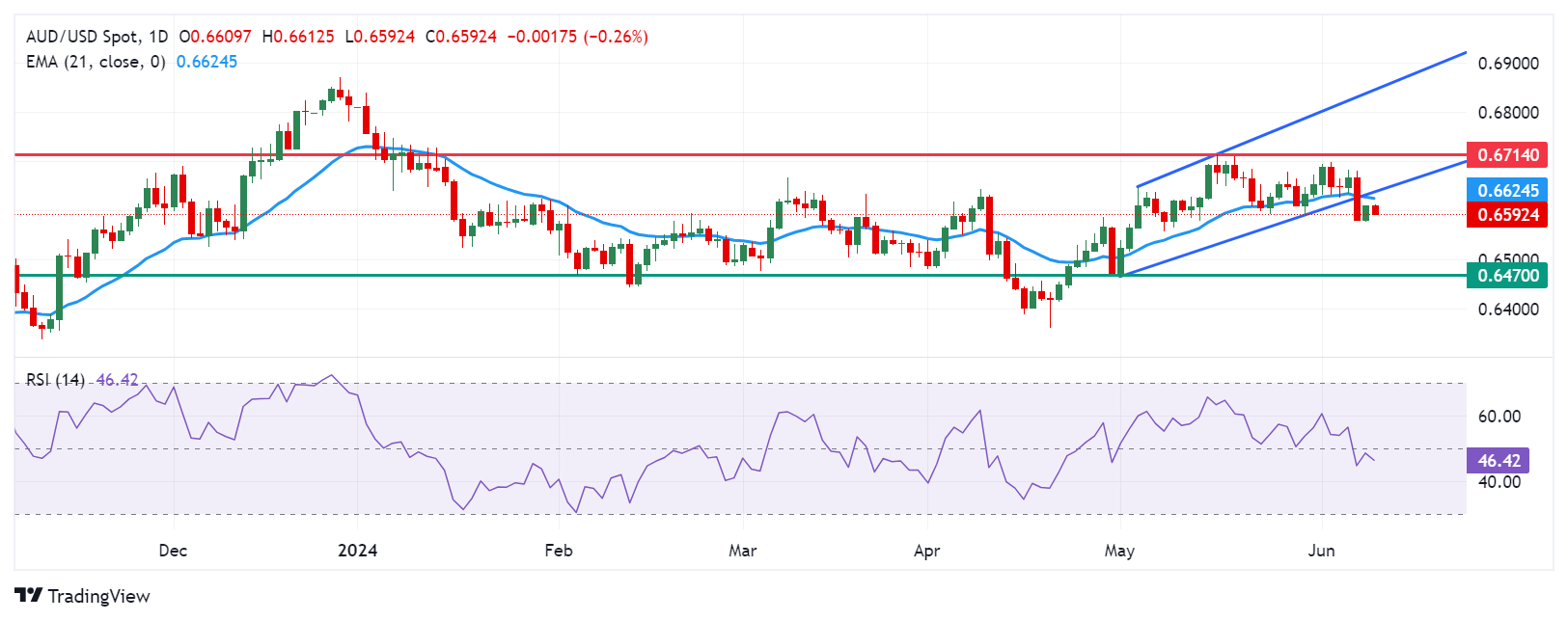- The Australian Dollar loses ground due to risk aversion as Fed decision looms.
- The Australian Dollar may limit its downside as the RBA is expected to maintain higher rates in 2024.
- The US Dollar holds ground as the Fed can be expected to keep rates steady in the range of 5.25%-5.50% on Wednesday.
The Australian Dollar (AUD) edges lower on Tuesday as the US Dollar (USD) remains strong, bolstered by robust US jobs data for May. This development has reduced the odds of two Federal Reserve (Fed) interest rate cuts in 2024. The CME FedWatch Tool indicates that the likelihood of a Fed rate cut in September by at least 25 basis points has decreased to nearly 49.0%, down from 59.5% a week earlier.
The downside for the Australian Dollar may be limited as traders expect the Reserve Bank of Australia (RBA) to maintain higher rates this year. Last week, RBA Governor Michele Bullock indicated that the central bank is prepared to increase interest rates if the Consumer Price Index (CPI) does not return to the target range of 1%-3%, according to NCA NewsWire.
The US Dollar (USD) maintains its position despite two days of declining US Treasury yields. Investors have become cautious ahead of the Federal Reserve's policy decision and key US inflation data expected on Wednesday. The Fed is anticipated to keep interest rates steady in the range of 5.25%-5.50% as it aims to curb inflation toward its 2% target. The US headline and core CPI figures for May are estimated to show year-over-year increases of 3.4% and 3.5%, respectively.
Daily Digest Market Movers: Australian Dollar declines due to risk aversion
- Australia's NAB Business Confidence index dropped to -3 index points in May, marking the lowest figure in six months and turning negative for the first time since last November. Meanwhile, Business Conditions fell to 6 index points, slightly below the long-run average.
- On Tuesday, National Australia Bank (NAB) Chief Economist Alan Oster commented, “There are warning signs on the outlook for growth but at the same time reasons to be very wary about the inflation outlook, and they expect the RBA to keep rates on hold for some time yet as they navigate through these contrasting risks,” as per the official transcript.
- Rabobank suggested in its report that the Federal Reserve may cut rates in September and December, more likely because of a deteriorating economy than because of progress on inflation. This is because they think that the US economy is entering a stagflationary phase with persistent inflation and an economic slowdown that is likely to end in a mild recession later this year.
- According to the US Bureau of Labor Statistics (BLS) on Friday, May's US Nonfarm Payrolls (NFP) increased by 272,000, up from 165,000 in April. The wage inflation, as measured by the Average Hourly Earnings, rose 4.1% YoY in May from 4.0% (revised from 3.9%) in April, above the market consensus of 3.9%.
- On Friday, Australia's Trade Balance widened to A$6,548 ($4,321.68) million MoM in May, exceeding the expected A$5,500 million and April's balance of A$5,024 million. Imports plunged by 7.2% MoM in May, swinging from April’s 4.2% increase. Exports shrank 2.5% following the previous decline of 0.6%.
Technical Analysis: Australian Dollar moves below 0.6600
The Australian Dollar trades around 0.6590 on Tuesday. Analysis of the daily chart indicates a weakening bullish bias for the AUD/USD pair, as it has dropped below the lower boundary of an ascending channel pattern. This is supported by the 14-day Relative Strength Index (RSI), which is slightly below the 50 level.
Key support levels are identified at 0.6550 and then 0.6500. A break below the latter could put pressure on the AUD/USD pair, pushing it toward the throwback support at 0.6470.
On the upside, the 21-day Exponential Moving Average (EMA) at 0.6625 serves as a key resistance, along with the lower boundary of the ascending channel around 0.6635. Re-entering the ascending channel pattern could strengthen the bullish bias, leading the AUD/USD pair to aim for the psychological level of 0.6700, followed by May’s high of 0.6714.
AUD/USD: Daily Chart

Australian Dollar price in the last 7 days
The table below shows the percentage change of the Australian Dollar (AUD) against listed major currencies in the last 7 days. The Australian Dollar was the weakest against the US Dollar.
| USD | EUR | GBP | CAD | AUD | JPY | NZD | CHF | |
| USD | 1.26% | 0.71% | 0.94% | 1.25% | 0.76% | 1.05% | 0.11% | |
| EUR | -1.28% | -0.56% | -0.33% | 0.00% | -0.51% | -0.21% | -1.17% | |
| GBP | -0.72% | 0.56% | 0.23% | 0.57% | 0.07% | 0.35% | -0.57% | |
| CAD | -0.95% | 0.32% | -0.23% | 0.33% | -0.19% | 0.12% | -0.83% | |
| AUD | -1.26% | -0.01% | -0.58% | -0.32% | -0.51% | -0.19% | -1.15% | |
| JPY | -0.78% | 0.49% | -0.06% | 0.17% | 0.49% | 0.31% | -0.64% | |
| NZD | -1.09% | 0.18% | -0.35% | -0.12% | 0.19% | -0.32% | -0.97% | |
| CHF | -0.12% | 1.13% | 0.57% | 0.80% | 1.14% | 0.64% | 0.94% |
The heat map shows percentage changes of major currencies against each other. The base currency is picked from the left column, while the quote currency is picked from the top row. For example, if you pick the Euro from the left column and move along the horizontal line to the Japanese Yen, the percentage change displayed in the box will represent EUR (base)/JPY (quote).













